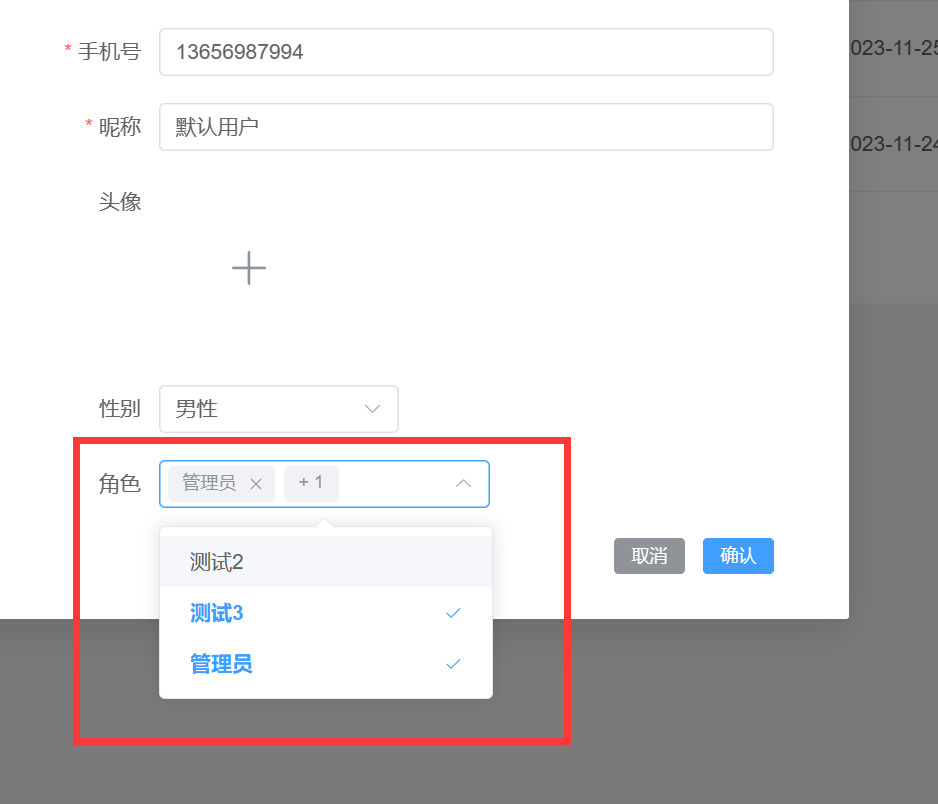用户角色
用户角色
建表
角色表
-- auto-generated definition
create table role
(
id varchar(36) not null
primary key,
created_time datetime(6) not null,
edited_time datetime(6) not null,
creator_id varchar(36) not null,
editor_id varchar(36) not null,
name varchar(36) not null,
constraint role_pk
unique (name)
);
用户角色关联表
-- auto-generated definition
create table user_role_rel
(
id varchar(36) not null
primary key,
created_time datetime(6) not null,
edited_time datetime(6) not null,
creator_id varchar(36) not null,
editor_id varchar(36) not null,
role_id varchar(36) not null,
user_id varchar(36) not null,
constraint role_id
unique (role_id, user_id)
);
实体类
Role
根据ER图中可以知道角色是权限模型的核心部分,它不仅和用户建立起了多对多关系,同时也和菜单建立起了多对多关系。UserRoleRel负责建立起用户和角色的多对多关联。
@GenEntity
@Entity
public interface Role extends BaseEntity {
@GenField(value = "角色名称")
@Key
String name();
@OneToMany(mappedBy = "role")
List<UserRoleRel> users();
}
相关信息
@OneToMany(mappedBy = "xxx")代表一对多映射,和ER图中的一对多相对应。
由于一对多的一方不存在外键,因此为了确定是哪张表关联了自己需要指定mappedBy = "xxx"。
@Key是业务主键。还有一种主键是@Id,这种主键和业务无关。
两者都可以唯一的标识一行记录,只是前者有业务的意义。如User表中的Phone也可以唯一代表一个用户,但是它多了一个业务含义——手机号。
BaseEntity包含通用的id, editedTime, createdTime, editor, creator。并且会在创建或者更新时自动填写这些字段。
UserRoleRel
要实现两个实体类的多对多关联必然需要一张中间表。UserRoleRel就是负责建立起User和Role这个联系的中间表。
除了BaseEntity中的逻辑主键@Id之外,还包含了两个业务主键@Key,分别是userId和roleId。他们组合起来可以唯一标识一行记录,因此加上了@Key。
用户拥有多个角色,当减少关联的角色时我们希望删除掉UserRoleRel中相应的记录。@OnDissociate(DissociateAction.DELETE)
即可达到这种脱钩操作。
@Entity
public interface UserRoleRel extends BaseEntity {
@ManyToOne
@Key
@OnDissociate(DissociateAction.DELETE)
User user();
@ManyToOne
@Key
Role role();
}
相关信息
@OnDissociate当删除时触发的脱钩操作。有级联删除/置空/检查报错。
User
在User中新增roles和rolesView。
@GenEntity
@Entity
public interface User extends BaseDateTime {
@Id
@GeneratedValue(generatorType = UUIDIdGenerator.class)
String id();
@GenField(value = "手机号", order = 0)
@Key
String phone();
@GenField(value = "密码", order = 1)
String password();
@GenField(value = "昵称", order = 2)
@Null
String nickname();
@GenField(value = "头像", order = 3, type = ItemType.PICTURE)
@Null
String avatar();
@GenField(value = "性别", order = 4, type = ItemType.SELECTABLE, dictEnName = DictConstants.GENDER)
@Null
DictConstants.Gender gender();
@Null
@OneToOne(mappedBy = "user")
UserWeChat wechat();
@OneToMany(mappedBy = "user")
List<UserRoleRel> roles();
}
相关信息
BaseEntity包含通用的 editedTime, createdTime。并且会在创建或者更新时自动填写这些字段。
生成角色增删改查
运行mall-server/src/test/java/io/qifan/mall/server/MallCodeGenerator.java。将template目录下的前后端增删改查复制到相应的位置,请参考开发流程。
用户角色创建
修改dto
Dto有input,view,speciation三种类型。input专门用于输入,在当前的场景中需要接收前端传入的roleIds。
因此要在UserInput中添加roleIds。
# mall-server/src/main/dto/io/qifan/mall/server/user/entity/User.dto
input UserInput {
#allScalars(User)
id?
# 新增roleIds
roleIds: Array<String>
}
后端实现
前端实现提交的数据结构如下
{
"createdTime": "2023-11-24 17:13:08",
"editedTime": "2023-11-29 17:09:43",
"id": "1cb4db50-66fa-4250-9916-73283e536fa0",
"phone": "13656987994",
"password": "$2a$10$UeZxmCdikKwYFK.wk7lp8Oj6ZzoXUZKUhV9qFGXuc74.IqgDP9AU2",
"nickname": "默认用户",
"avatar": null,
"gender": "0710c8a5-021c-404d-b09e-56db95c259e9",
"roleIds": [
"1",
"17509f5c-9a6b-429c-b467-cadbd8873d2d"
]
}
在图1中可知选中了两个角色,所以roleIds里面包含两条id数据。
- UserInput中有roleIds,需要转成User中的
List<UserRoleRel> roles(); - UserInput是User的Dto,因此它可以通过userInput.toEntity()转成User对象
- 由于User是不可变对象,要修改需要同Draft对象。如UserDraft
通过上面三点可以知道Input类型的Dto插入到数据库需要哪些步骤,在UserService的save方法中新增下面的代码。
public String save(UserInput userInput) {
User user = userInput.toEntity();
return userRepository.save(UserDraft.$.produce(user, draft -> {
// 将List<String> roleIds map映射--> List<UserRoleRel> roles
Arrays.stream(userInput.getRoleIds()).forEach(roleId -> {
// 向user对象中添加UserRoleRel
draft.addIntoRoles(userRole -> {
// 设置UserRoleRel,
userRole.applyRole(role -> role.setId(roleId));
// user中有@Key phone,要不然需要创建完用户得到id才可以。
userRole.setUser(user);
});
});
})).id();
}
前端实现
使用RemoteSelect组件即可实现下图效果

提供待选项获取方法
const roleQueryOptions = async (keyword: string) => { return (await api.roleController.query({ body: { query: { name: keyword } } })).content }双向绑定已选的角色
在user-store.ts中定义了
createForm,类型是UserInput。在dto修改中新增了roleIds,代表前端需要传roleIds。// roleIds和remote-select双向绑定 const initForm: UserInput = { roleIds: [], password: '', nickname: '', phone: '' } const createForm = ref<UserInput>(initForm)映射待选项到label和value
<remote-select :query-options="roleQueryOptions" v-model="updateForm.roleIds" label-prop="name" multiple >label-prop="name"代表角色的名称映射到el-option的label属性value-prop="id""代表角色的id映射到el-option的value属性(默认就是id,所以这边没填)
汇总
<script lang="ts" setup>
const userStore = useUserStore()
const { createForm } = storeToRefs(userStore)
// 获取角色列表
const roleQueryOptions = async (keyword: string) => {
return (await api.roleController.query({ body: { query: { name: keyword } } })).content
}
</script>
<template>
<div class="create-form">
<el-form ref="createFormRef" :model="createForm" :rules="rules" class="form" labelWidth="120">
<el-form-item label="角色">
<!-- 双向绑定和定义映射 -->
<remote-select
:query-options="roleQueryOptions"
v-model="createForm.roleIds"
label-prop="name"
multiple
>
</remote-select>
</el-form-item>
</el-form>
</div>
</template>
相关信息
RemoteSelect组件:快速选择远程数据
编辑用户(回显)修改角色
当创建完用户之后,当编辑用户的时候需要显示用户已有的角色。
- 后端查询编辑用户的角色
- 前端遍历roleVies得到roleIds
- 双向绑定到RemoteSelect组件即可实现默认选中已有的角色
视图属性RolesView
rolesView是roles的视图属性,获得UserRoleRel中的role得到List<Role>。
@ManyToManyView(
prop = "roles",
deeperProp = "role"
)
List<Role> rolesView();
相关信息
@ManyToManyView:
在权限模型中,如果用户需要获得它关联的角色,需要通过下面这种方式获得List<Role> roles=user.getRoles().map(userRoleRel -> userRoleRel.getRole()).toList();。
使用@ManyToManyView可以便捷的将UserRoleRel中的Role获取。
属性抓取
在UserRepository中定义了一个通用的对象抓取器。在这个数据抓取,.allScalarFields()代表抓取普通属性。后面又新增了rolesView(RoleFetcher.$.name())抓取角色视图且列表中的角色只抓取name字段,这样就可以返用户关联的角色。
UserFetcher USER_ROLE_FETCHER = UserFetcher.$.allScalarFields().rolesView(RoleFetcher.$.name());
返回的结果,可以看见除了普通属性之外,还包含了一个视图属性rolesView
{
"code": 1,
"msg": "操作成功",
"result": {
"createdTime": "2024-01-10 10:48:02",
"editedTime": "2024-01-15 14:45:10",
"id": "0f07d638-f1bc-4011-88d8-6dc650ab06a7",
"phone": "13656987994",
"password": "$2a$10$pl/GmO3mDaqWjBtmfXzppOFQwnW/jlinORR6.83Lo7QdTuU4uh5AG",
"nickname": "默认用户",
"avatar": "https://my-community.oss-cn-qingdao.aliyuncs.com/20240110212158起凡.jpg",
"gender": "PRIVATE",
"rolesView": [
{
"id": "4a83f185-30bb-4464-9e68-239698e89a5e",
"name": "普通用户"
},
{
"id": "5f785900-d317-4210-979d-d17a40ba8ecc",
"name": "管理员"
}
]
},
"success": true
}
返回形状
之前的查询用户信息并没有返回角色信息。将UserController中的用户信息查询接口返回形状指定为USER_ROLE_FETCHER
@GetMapping("{id}")
public @FetchBy(value = "USER_ROLE_FETCHER") User findById(
@PathVariable String id) {
return userService.findById(id);
}
@GetMapping("user-info")
public @FetchBy(value = "USER_ROLE_FETCHER") User getUserInfo() {
return userService.getUserInfo();
}
前端遍历获取roleId
前端将res.rolesView映射成roleIds
const res = await api.userController.findById({ id: updateForm.value.id || '' })
updateForm.value = { ...res, roleIds: res.rolesView.map((role) => role.id) }
双向绑定roleIds
由于roleIds中已经有值,此时下拉框中会选中该用户已有的角色。
<remote-select
:query-options="roleQueryOptions"
v-model="updateForm.roleIds"
label-prop="name"
multiple
>
</remote-select>
